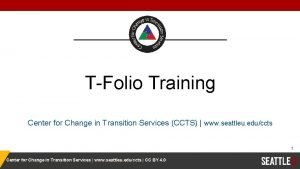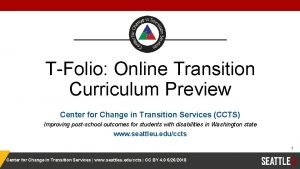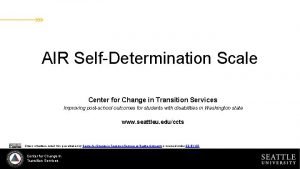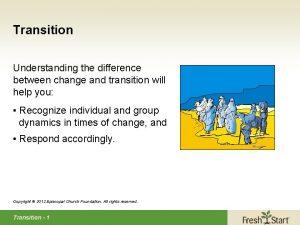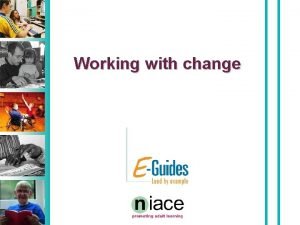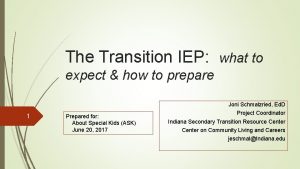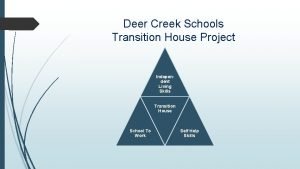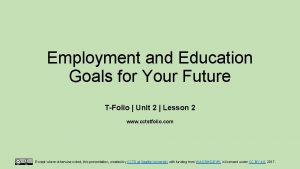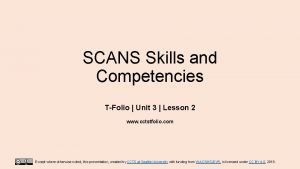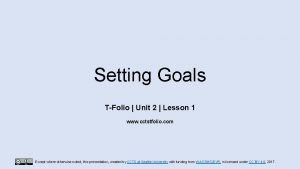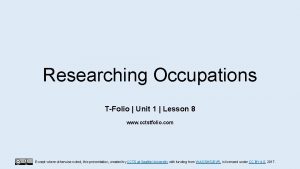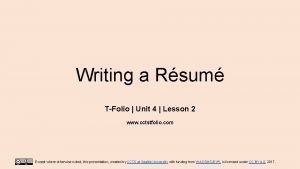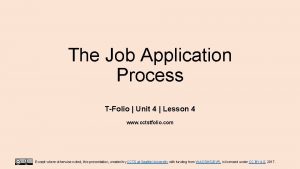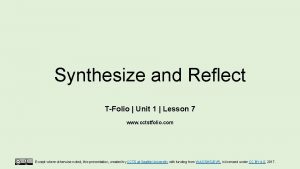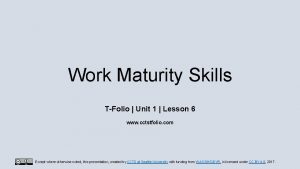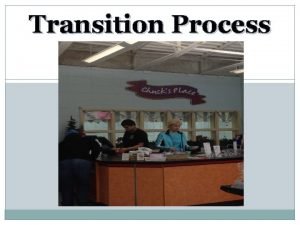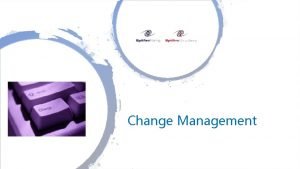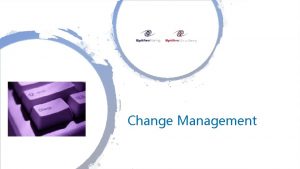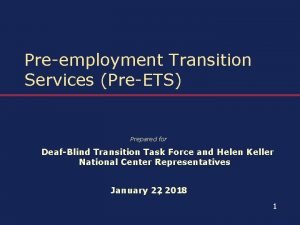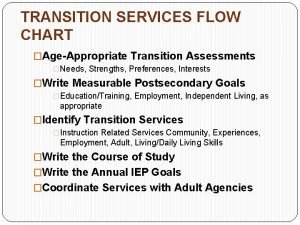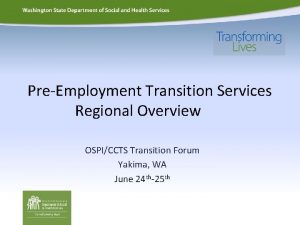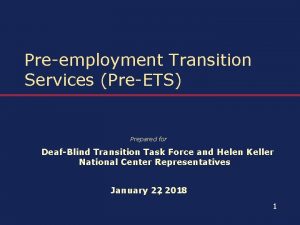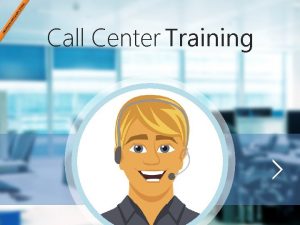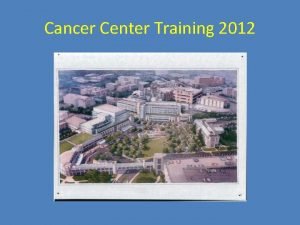TFolio Training Center for Change in Transition Services










































- Slides: 42

T-Folio Training Center for Change in Transition Services (CCTS) | www. seattleu. edu/ccts 1 Center for Change in Transition Services | www. seattleu. edu/ccts | CC BY 4. 0

Training Objectives, Part 1: The Basics • What is T-Folio? • Who should use T-Folio? • How to implement the curriculum • What is included • How to navigate the lessons and activities 2 Center for Change in Transition Services | www. seattleu. edu/ccts | CC BY 4. 0

Training Objectives, Part 2: Collaboration and Facilitation • How to collaborate effectively between educators and agency personnel • Tips from the field on collaboration • Suggestions on how to facilitate a lesson with youth 3 Center for Change in Transition Services | www. seattleu. edu/ccts | CC BY 4. 0

Part 1: The Basics 4 Center for Change in Transition Services | www. seattleu. edu/ccts | CC BY 4. 0

What is the T-Folio? • A free digital platform that helps youth in Washington state complete the items needed for their transition portfolios through a series of interactive exercises and the support of a facilitator. • Aligns with both Individualized Education Program (IEP) transition planning and the Division of Vocational Rehabilitation’s Pre-Employment Transition Services. • Schools and counselors are already required to provide transition services. The T-Folio is a supplemental tool that makes it easier! 5 Center for Change in Transition Services | www. seattleu. edu/ccts | CC BY 4. 0

Transition Services The T-Folio curriculum is aligned with the Transition Services Flowchart (Johnson, 2012) and is designed to guide youth through the process of planning for their future and setting goals for: • the IEP (Individualized Education Program) • the IPE (Individual Plan for Employment) 6 Center for Change in Transition Services | www. seattleu. edu/ccts | CC BY 4. 0

Who should use the T-Folio? • T-Folio is designed for youth aged 16 -25 who are in the process of transitioning from high school to post-secondary employment or higher education. • T-Folio is primarily designed for students who fall into the high incidence categories (SLD, EBD, Health Impaired, etc. ) • Activities have been carefully constructed to incorporate universal design principles and can be modified to meet the needs of a wider range of student abilities. 7 Center for Change in Transition Services | www. seattleu. edu/ccts | CC BY 4. 0

How to implement the curriculum • Implement the curriculum in classes that already exist: − English Language Arts − Life Skills − Career Technical Education − Advisory − Community Experience Class − Etc. • In small groups or individually to prepare for the development of an IPE with the help of a DVR counselor. 8 Center for Change in Transition Services | www. seattleu. edu/ccts | CC BY 4. 0

Partner with others • • CTE teacher School counselor Business partners Guest speakers. Use technology to invite speakers into your classroom via Zoom, Skype, etc. 9 Center for Change in Transition Services | www. seattleu. edu/ccts | CC BY 4. 0

Suggestions for timing when integrating T-Folio The curriculum can be used throughout the student’s high-school career, as they will benefit from repeating or revisiting certain lessons each year. • Age appropriate assessments should be done every year. • Goals (postsecondary and annual IEP) can be written and led by the student and need to be reviewed/adjusted annually. • Preparing for employment varies as the student matures – revisiting these areas will lead to better outcomes. • Self-advocacy is an ongoing area of growth for youth as they experience and mature in their transition – revisit and practice often. 10 Center for Change in Transition Services | www. seattleu. edu/ccts | CC BY 4. 0

High School and Beyond Plan Many T-Folio activities align with the High School and Beyond Plan (HSBP) required for all students for graduation, including: • • • Career Interest Inventory (see T-Folio Unit 1, Lesson 3) Educational goals (Unit 2, Lesson 2) Course planner (Unit 2, Lesson 5) Personalized pathway (Unit 2, Lesson 7) Resume/activity log (Unit 4, Lesson 2) 11 Center for Change in Transition Services | www. seattleu. edu/ccts | CC BY 4. 0

T-Folio Units • Student-Centered Introduction • Unit 1: Job Exploration Groundwork • Unit 2: Postsecondary Employment and Education Options • Unit 3: Work-based Learning Experiences • Unit 4: Workplace Readiness Training • Unit 5: Self-Advocacy 12 Center for Change in Transition Services | www. seattleu. edu/ccts | CC BY 4. 0

Student-Centered Introduction • A warm-up unit for both youth and facilitators. • Promotes student voice. • Emboldens the students to self-reflect and explore what is important to them and their future. • Increases understanding and ability to identify and voice future desires. 13 Center for Change in Transition Services | www. seattleu. edu/ccts | CC BY 4. 0

Unit 1: Job Exploration Groundwork • This unit consists of 8 lessons. • A series of assessments in areas of strengths, preferences, interests, needs, self-determination, and work maturity skills. • Students will analyze results of the assessments and identify connected traits in relation to potential careers. 14 Center for Change in Transition Services | www. seattleu. edu/ccts | CC BY 4. 0

Unit 2: Postsecondary Employment and Education Options • This unit consists of 7 lessons which follow the Transition Flowchart. • In this unit, participants will: − Explore and create their postsecondary education and training goals. − Chart their course of study. − Create an action plan for employment and education. 15 Center for Change in Transition Services | www. seattleu. edu/ccts | CC BY 4. 0

Unit 3: Work-based Learning Experiences This unit consists of 6 lessons that assist students with cultivating experiences that will help prepare them for future careers: 1. Introduction to work-based learning. 2. Workplace skills and competencies. 3. Informational interviews. 4. Job shadowing. 5. Evaluations and letters of recommendation. 6. High School and Beyond Plan alignment. 16 Center for Change in Transition Services | www. seattleu. edu/ccts | CC BY 4. 0

Unit 4: Workplace Readiness Training This unit has 7 lessons in which students will learn about: 1. Work maturity skills 2. Writing a resume 3. Writing and presenting an elevator speech 4. Job applications 5. Job interview preparation 6. Writing a thank you note 7. Developing an action plan for employment 17 Center for Change in Transition Services | www. seattleu. edu/ccts | CC BY 4. 0

Unit 5: Self Advocacy This unit has 6 lessons in which students will : 1. Reassess their level of self-determination. 2. Set goals in the area of self-advocacy. 3. Set goals for independent living. 4. Learn about student-led IEPs. 5. Create an action plan for self-advocacy and independent living. 6. Review their work in the T-Folio for completion. 18 Center for Change in Transition Services | www. seattleu. edu/ccts | CC BY 4. 0

Getting Started • Go to www. cctstfolio. com • Chrome has the best functionality • There may be a short wait as the platform loads • Familiarize yourself with the units, lesson guides, and activities • Keep in mind as you are exploring that all Word and Power. Point documents will download automatically, while PDFs will open in a new tab. 19 Center for Change in Transition Services | www. seattleu. edu/ccts | CC BY 4. 0

Lesson landing page 20 Center for Change in Transition Services | www. seattleu. edu/ccts | CC BY 4. 0

What a typical lesson includes • Lesson guide • Activity (one or more) • Power. Point (and PDF) 21 Center for Change in Transition Services | www. seattleu. edu/ccts | CC BY 4. 0

Lesson Guides Lesson guides are available on each lesson landing page and include the following: • Lesson summary and objectives • Facilitator notes • Introduction to the lesson with script suggestions • Activities • Debrief and guiding questions • Additional resources • Considerations for accommodation 22 Center for Change in Transition Services | www. seattleu. edu/ccts | CC BY 4. 0

Lesson Guide: Example 23 Center for Change in Transition Services | www. seattleu. edu/ccts | CC BY 4. 0

Accessing the Power. Point 24 Center for Change in Transition Services | www. seattleu. edu/ccts | CC BY 4. 0

Power. Points • Most lessons have an accompanying Power. Point to use as presentation or guide. • Guides the facilitator and youth through the lesson. • Many slides have notes that support the information on the slide. • Includes links to the activities to be used in the lesson. • The Power. Points are left purposefully sparse to meet maximum accessibility requirements. However, facilitators can feel free to add images or transitions according to preference. 25 Center for Change in Transition Services | www. seattleu. edu/ccts | CC BY 4. 0

Accessing the activities 26 Center for Change in Transition Services | www. seattleu. edu/ccts | CC BY 4. 0

Activities • Each lesson has at least one activity for the youth to complete. • The lesson guide provides the facilitator with directions and locations of the activity(s). • There is a “product” at the end of each activity that will need to be saved in some location as a PDF: − Cloud-based − Thumb drive − Printed portfolio 27 Center for Change in Transition Services | www. seattleu. edu/ccts | CC BY 4. 0

Save your work Important! The T-Folio will not store any of the user’s work or information. It is therefore recommended that youth save their work once it is completed by creating a PDF of the activity. First, after the activity has been completed, click on the “Print” button. 28 Center for Change in Transition Services | www. seattleu. edu/ccts | CC BY 4. 0

How to “Save as PDF” Then, from the print screen, choose "Save as PDF” by changing the printer destination. 29 Center for Change in Transition Services | www. seattleu. edu/ccts | CC BY 4. 0

Where to save work • Choose a descriptive file name and save to a place where the student will be able to access it (local computer, thumb drive, school district server). • Once the form is saved, it can also be printed and added to the student’s file. • Plan activities to be completed in one sitting to avoid lost work. 30 Center for Change in Transition Services | www. seattleu. edu/ccts | CC BY 4. 0

T-Folio Tracker The T-Folio Tracker is how youth will track their work. 31 Center for Change in Transition Services | www. seattleu. edu/ccts | CC BY 4. 0

The “White List” • Some schools and organizations have firewalls or other protections in place that block access to T-Folio content. • A "white list" is available for download for your IT department to add to the list of URLs recognized as safe. • The T-Folio White List can be accessed from the CCTS website. 32 Center for Change in Transition Services | www. seattleu. edu/ccts | CC BY 4. 0

Part 2: Collaboration & Facilitation 33 Center for Change in Transition Services | www. seattleu. edu/ccts | CC BY 4. 0

Collaboration • The T-Folio curriculum can be co-facilitated by school personnel and DVR. • The curriculum is designed to be flexible in its delivery where all or some lessons can be co-facilitated. • The ideal implementation would allow for planning time where both facilitators identify their areas of focus and expertise as they prepare for working with youth. 34 Center for Change in Transition Services | www. seattleu. edu/ccts | CC BY 4. 0

Tips for successful collaboration • Establish rapport. • Identify your styles and use them to create a cohesive instructional setting. • Discuss strengths and weaknesses. • Discuss individualized needs and overall goals. • Formulate a plan of action and act as a unified team. • Take risks and grow. 35 Center for Change in Transition Services | www. seattleu. edu/ccts | CC BY 4. 0

Classroom teachers • Review the curriculum together. • Ask for support. • Support your co-facilitator. • Create a calendar of instruction. 36 Center for Change in Transition Services | www. seattleu. edu/ccts | CC BY 4. 0

DVR personnel • Believe that all students should be held to high expectations. • Bring your best. • Expect that you will have a positive impact in every youth’s life. • Believe that all students can succeed. • Be flexible with timing. • Be prepared to change course. • Have fun! 37 Center for Change in Transition Services | www. seattleu. edu/ccts | CC BY 4. 0

Tips from the field for DVR counselors • Talk to teachers before implementing T-Folio in the classroom about what their students need. • Go through the activities and think about what students need and what isn’t being delivered in the classroom – don’t duplicate those services. • Share with teachers some of the information you’ll be covering before going into the workshop – you’ll be more effective as a team in making sure students are really grasping the concepts. • Check for comprehension, have the students share out, be conversational. 38 Center for Change in Transition Services | www. seattleu. edu/ccts | CC BY 4. 0

Reminders about facilitation DON’T: Start out with your own knowledge. Follow a pre-set curriculum. Lecture from the “stage. ” Provide information in one direction. DO: Start by assessing the group. Consider new ideas brought in by the group. Use practical, participatory methods. Make sure information flows in all directions and learning happens among all participants. Act as if there is a “right” answer. Maintain a hierarchical relationship with pupils. Answer all questions yourself. Encourage and value different views. Consider participants as being equal. Ask participants what they think and let them figure things out for themselves. (Adapted from Geijer, 2015) Center for Change in Transition Services | www. seattleu. edu/ccts | CC BY 4. 0 39

References Geijer, C. C. (2015, January 15). Teaching vs. facilitating: What is the difference? Retrieved from: https: //www. linkedin. com/pulse/whats-difference-between-teacher-facilitator-christina-geijer Johnson, C. E. (2012). Transition Services Flowchart. Center for Change in Transition Services, Seattle University. Seattle, WA. 40 Center for Change in Transition Services | www. seattleu. edu/ccts | CC BY 4. 0 2018

CCTS Contact CCTS General Information ccts@seattleu. edu 206 -296 -6494 www. seattleu. edu/ccts 41 Center for Change in Transition Services | www. seattleu. edu/ccts | CC BY 4. 0 2018

Creative Commons License • Except where otherwise noted, content in this presentation is licensed under a Creative Commons Attribution 4. 0 International license. All logos and trademarks are property of their respective owners. • You may share and adapt this material, but you must give appropriate credit, provide a link to the license, and indicate if changes were made. 42 Center for Change in Transition Services | www. seattleu. edu/ccts | CC BY 4. 0 2018
 Center for change in transition services
Center for change in transition services Center for change in transition services
Center for change in transition services Tfolio
Tfolio Air self determination
Air self determination Wake county human services community services center
Wake county human services community services center Change and transition difference
Change and transition difference Difference between transition and change
Difference between transition and change Change transition curve
Change transition curve Red lodge transition services
Red lodge transition services Indiana secondary transition resource center
Indiana secondary transition resource center Deer creek transition center
Deer creek transition center Burger transition center
Burger transition center Fspos vägledning för kontinuitetshantering
Fspos vägledning för kontinuitetshantering Typiska novell drag
Typiska novell drag Nationell inriktning för artificiell intelligens
Nationell inriktning för artificiell intelligens Returpilarna
Returpilarna Varför kallas perioden 1918-1939 för mellankrigstiden
Varför kallas perioden 1918-1939 för mellankrigstiden En lathund för arbete med kontinuitetshantering
En lathund för arbete med kontinuitetshantering Personalliggare bygg undantag
Personalliggare bygg undantag Personlig tidbok för yrkesförare
Personlig tidbok för yrkesförare A gastrica
A gastrica Densitet vatten
Densitet vatten Datorkunskap för nybörjare
Datorkunskap för nybörjare Boverket ka
Boverket ka Mall debattartikel
Mall debattartikel Autokratiskt ledarskap
Autokratiskt ledarskap Nyckelkompetenser för livslångt lärande
Nyckelkompetenser för livslångt lärande Påbyggnader för flakfordon
Påbyggnader för flakfordon Tryck formel
Tryck formel Publik sektor
Publik sektor Lyckans minut erik lindorm analys
Lyckans minut erik lindorm analys Presentera för publik crossboss
Presentera för publik crossboss Argument för teckenspråk som minoritetsspråk
Argument för teckenspråk som minoritetsspråk Bat mitza
Bat mitza Treserva lathund
Treserva lathund Fimbrietratt
Fimbrietratt Bästa kameran för astrofoto
Bästa kameran för astrofoto Cks
Cks Byggprocessen steg för steg
Byggprocessen steg för steg Bra mat för unga idrottare
Bra mat för unga idrottare Verktyg för automatisering av utbetalningar
Verktyg för automatisering av utbetalningar Rutin för avvikelsehantering
Rutin för avvikelsehantering Smärtskolan kunskap för livet
Smärtskolan kunskap för livet
